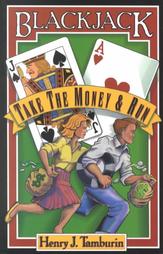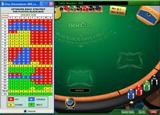
Blackjack: Take The Money and Run
How the MIT Students Beat the Casinos at Blackjack
Bringing Down The House by Ben Mezrich, a book that describes how a team of MIT students won millions playing blackjack, has sparked a lot of interest from the general public in blackjack and Henry Tamburin is the editor and publisher of the Blackjack Insider Newsletter and author of the best-selling Blackjack: Take the Money & Run. He is also the lead Instructor for the Golden Touch Blackjack course, a feature writer for Casino Player magazine (and 6 other publications); an owner of a casino gambling publishing company (www.rsucasinobooks.com) and the host of www.smartgaming.com. For a free three month subscription to the Henry's Blackjack Insider Newsletter with full membership privileges go to www.bjinsider.com/free. Henry's website is www.smartgaming.com in particular card counting. The book has been a NY Times bestseller and recently there was a documentary about the MIT team on cable television. In addition several of the MIT players appeared on the televised World Series of Blackjack (WSB) tournament and the soon to be televised Ultimate Blackjack Tour. Between the book, the documentary, and televison appearances it’s no wonder I’ve been receiving a lot more inquiries about how this team of students was able to pull off their big score. Here is how they did it.
Henry Tamburin is the editor and publisher of the Blackjack Insider Newsletter and author of the best-selling Blackjack: Take the Money & Run. He is also the lead Instructor for the Golden Touch Blackjack course, a feature writer for Casino Player magazine (and 6 other publications); an owner of a casino gambling publishing company (www.rsucasinobooks.com) and the host of www.smartgaming.com. For a free three month subscription to the Henry's Blackjack Insider Newsletter with full membership privileges go to www.bjinsider.com/free. Henry's website is www.smartgaming.com in particular card counting. The book has been a NY Times bestseller and recently there was a documentary about the MIT team on cable television. In addition several of the MIT players appeared on the televised World Series of Blackjack (WSB) tournament and the soon to be televised Ultimate Blackjack Tour. Between the book, the documentary, and televison appearances it’s no wonder I’ve been receiving a lot more inquiries about how this team of students was able to pull off their big score. Here is how they did it.
First off, they didn’t cheat. They basically learned the following skills- the basic playing strategy, card counting, and team play - to win at blackjack.
Basic strategy is simply a set of rules that tells you the best way to play every hand dealt to you. For example, one of the basic strategy plays is to always split aces and 8s no matter what the dealer’s upcard. You can find the basic strategy in blackjack books (including my Blackjack: Take The Money & Run) and it is a pre-requisite for winning at blackjack.
Next the MIT team members learned a card counting system. The latter is a way to keep track of the cards as they are played after a shuffle. A grouping of cards, for example the 2 through 6’s, are assigned a value or tag of plus 1. Likewise the high cards – tens, picture cards and aces – have a minus 1 tag. They add and subtract the tags for each card that is played from the shuffled deck(s) to arrive at a sum known as the running count. The more positive the running count, the more high cards are left in the undealt cards which gave them the advantage, so they bet more (often tens of thousands). When the running count was negative, they bet less because there is an abundance of small cards left in the undealt cards a situation which gave the house a decided advantage. The team members therefore, waited for the deck to get good before they bet large sums of money.
The member of the MIT team did not play solo much like most card counters would do. They went one step further by using spotters, Big Players, and a team bank. Here’s how this works.
Several spotters would enter a casino and position themselves at different blackjack tables. They counted and when the count went positive, they wouldn’t increase their bets, but rather signal another team member (known as the BP or Big Player) to enter the game with big bets. The BP continues to bet big until the spotter gives another signal that the deck has gone bad (or negative) and then the BP leaves the table. The BP basically wanders around the casino waiting for another call-in from a spotter.
Because the spotters always bet the minimum on every hand the casino is less likely to finger them as card counters. The BP acts and appears as just another high roller as he enters the game making large bets hand after hand. Depending on how high the count was when he’s signaled in to the game, the BP’s edge can be quite high.
The BP must know the spotter’s signals. For example here’s a few signals mentioned in the book.
Running hand through hair means something is wrong-get out of the casino fast.
Besides the physical signals, there team also used oral signals to indicate to the BP what the count was so the BP knew how much to bet. These oral signals were key words that they would in a sentence. For example, tree meant a count of plus 1. Stool was plus 3, bowling was plus 10. So if the spotter said something like “I’d rather be bowling right now” that indicated to the BP that the count was plus 10 and therefore he knew how much to bet.
Probably the biggest weapon the MIT team had going was a team bankroll. Not only did each player put up a sum of money, but investors had invested in the team. With one large team bank, every player on the team used this one combined, large bankroll as if it were his or her individual bankroll. This in turn allowed the MIT team players to bet larger amounts of money with the same risk compared to playing solo. And the greater amount of money that a card counter can get on the table, the more money he or she stands to win. This is what makes blackjack teams so powerful.
Here’s an example of how a team bank works compared to a card counter that plays alone. Suppose Player A plays solo with a $5,000 bankroll and wagers up to a $100 per hand when the advantage shifts in his favor. His earning potential as a card counter is $25 per hour.
Player B joins Player A to form a team. Their combined bank is $10,000 allowing each player to increase their maximum bet from $100 to $200. The team of two players profit potential is now $100 per hour so each player averages $50 per hour profit, twice the earnings compared to playing solo.
As a general rule the profit potential of a team of skilled players is equal to the profit potential of each individual if playing solo times the number of players on the team squared. So if a card counter has the potential to earn $25 per hour playing blackjack, this is what he could earn playing on a team.
Solo Earnings Potential Number of Team Players Individual Earnings on Team
The more members on the team the more money a card counter stands to earn. And of course the more you money you wager the higher the individual earnings.
Playing on a team also smoothes out the bumps in the road and makes the negative swings more manageable and tolerable. Teams also play more hands per hour compared to a solo player so they will get into the “long run” a lot quicker. This means that the probability is higher that a team of players will be ahead after playing x hours compared to a solo player playing the same x hours.
The life of a card counter can be lonely especially when they are losing. But when they are playing on a team and have a disastrous losing day, members often provide support and sympathize with their plight (this is clearly brought out in the book). There is also the possibility that even though one member of a team lost, other team members have won. Secondly, having a group of individuals trying to achieve the same goal (winning x amount of money) often provided an uplifting psychology advantage. Thirdly, team players are more apt to share intelligence about games with better rules and penetration which makes winning easier for all team members.
It took months and months of practice before the MIT team members were ready to take on the casinos. And even though they won money in the long run, over a few days and weeks of play they took their lumps, which is normal for card counting. Their key to success was their understanding of risk and return and their large bankroll.

